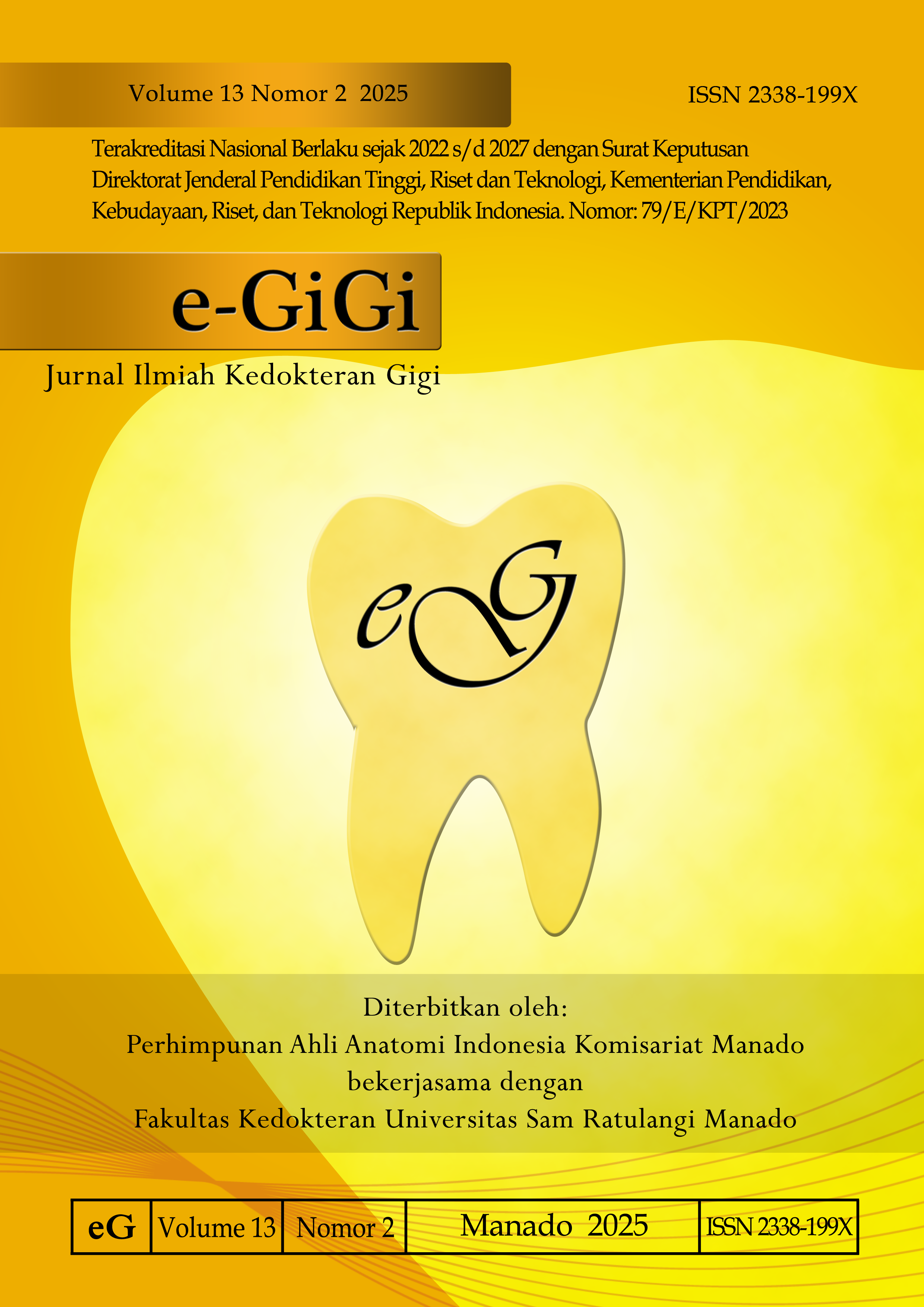Gambaran Persepsi Mahasiswa Profesi terhadap Budaya Keselamatan Pasien
DOI:
https://doi.org/10.35790/eg.v13i2.53452Abstract
Abstract: Patient safety is a major thing of concern worldwide, particularly for medical personnel in preventing patient injuries during treatment. Patient safety incidents are also a concern for the government and the health community in Indonesia. This study aimed to obtain the perception of patient safety culture among professional students at the Faculty of Dentistry, Universitas Trisakti, specifically at RSGM-P FKG Usakti. This was a descriptive and observational stufy with a cross-sectional design conducted through online. The total number of respondents in this study was 250 professional students at RSGM-P Faculty of Dentistry, Universitas Trisakti. The results showed a response rate of 56.1%. Positive patient safety culture values were at 46.8%, while negative patient safety culture values were at 53.2%. Categorically, positive patient safety culture values were rated as very good (23.2%), good (23.6%), moderate (30.8%), and poor (22.4%). Meanwhile, negative patient safety culture values were rated as moderate (30.8%) and poor (22.4%). In conclusion, patient safety factors still dominate positive perceptions of professional students. Despite the slightly higher percentage of negative patient safety culture value compared to positive value. safety climate factor still dominates the perception of professional students.
Keywords: perception; professional dentistry students; patient safety culture
Abstrak: Keselamatan pasien merupakan hal utama yang menjadi perhatian masyarakat dunia khususnya tenaga medis guna mencegah terjadinya cedera pasien selama perawatan. Insiden keselamatan pasien juga menjadi perhatian bagi pemerintah maupun masyarakat kesehatan di Indonesia. Penelitian ini bertujuan untuk mengetahui gambaran dan persepsi budaya keselamatan pasien (BKP) pada mahasiswa profesi di RSGM-P FKG Universitas Trisakti. Jenis penelitian ialah observasional deskriptif dengan desain potong lintang yang dilakukan secara daring. Jumlah responden penelitian ini sebanyak 250 mahasiswa profesi di RSGM-P FKG Usakti. Hasil penelitian mendapatkan response rate sebesar 56,1%. Nilai BKP positif sebesar 46,8%, nilai BKP negatif sebesar 53,2%. Kategori nilai BKP positif ialah nilai sangat baik (23,2%), baik (23,6%), sedang (30,8%), dan kurang (22,4%).Simpulan penelitian ini ialah faktor budaya keselamatan pasien masih mendominasi persepsi positif para mahasiswa profesi. Walaupun hasil nilai budaya keselamatan pasien menunjukan negatif sedikit lebih tinggi daripada positif tetapi faktor keselamatan atau safety climate masih mendominasi persepsi para mahasiswa profesi.
Kata kunci: persepsi; mahasiswa profesi Kedokteran Gigi; budaya keselamatan pasien
References
Neri RA, Lestari Y, Yetti H. Analisis pelaksanaan sasaran keselamatan pasien di rawat inap Rumah Sakit Umum Daerah Padang Pariaman. J Kesehat Andalas. 2018;7:48. Doi:10.25077/jka.v7i0.921
Herawati YT. Budaya Keselamatan Pasien di Ruang Rawat Inap Rumah Sakit X Kabupaten Jember. J IKESMA. 2015;11(1):52-60.
Al-Surimi K, Alayadi H, Salam M. Female dental students’ perceptions of patient safety culture: a cross sectional study at a middle eastern setting. BMC Med Educ. 2018;18(1):1-10. Doi:10.1186/s12909-018-1415-8
Al Nadabi W, Faisal M, Mohammed MA. Patient safety culture in Oman: a national study. J Eval Clin Pract. 2019;24(5):1406-15. Doi:10.1111/jep.13322
Yasmi Y, Thabrany H. Faktor-faktor yang berhubungan dengan budaya keselamatan pasien di Rumah Sakit Karya Bhakti Pratiwi Bogor tahun 2015. J Adm Rumah Sakit Indones. 2018;4(2):98-109. Doi:10.7454/arsi.v4i2.2563
Tiwana KK, Kutcher MJ, Phillips C, Stein M, Oliver J. Gender issues in clinical dental education. J Dent Educ. 2014;78(3):401-10. Doi:10.1002/j.0022-0337.2014.78.3.tb05690.x
Juliawati M, Darwita RR, Adiatman M, Lestari F. Patient safety culture in dentistry analysis using the safety attitude questionnaire in DKI Jakarta, Indonesia. J Patient Saf. 2022;18(5)486-93. Doi: 10.1097/PTS.0000000000000980
Mallapiang F, Ibrahim H, Arifuddin NF, Azriful A, Surahmawati S. An overview of role tim work dimension, adequate staff and health workers’ perception of patients safety culture. Hospital Management Studies Journal. 2021;2(2):112–9. Available from: https://doi.org/10.24252/hmsj.v2i2.21043
Frasticha LA, Nurdin A, Fitria U, Dinen KA, Kurnia R. Peran aspek etika tenaga medis dalam penerapan budaya keselamatan pasien di rumah sakit. PHJ. 2023;0:443-51. Available from: https://teewanjournal. com/index.php/phj/index
Pamungkasari EP, Probandari A. Pengukuran kemampuan belajar mandiri pada mahasiswa pendidikan profesi dokter. Jurnal Penelitian dan Evaluasi Pendidikan, 2012;16(2):492-510. Doi: 10.21831/pep.v16i2.1128
Wianti A, Setiawan A, Murtiningsih M, Budiman B, Rohayani L. Karakteristik dan budaya keselamatan pasien terhadap insiden keselamatan pasien. Jurnal Keperawatan Silampari. 2021;5(1):96–102. Doi: https://doi.org/10.31539/jks.v5i1.2587
Cheng HC, Ming AFY, Lee YH. Factors affecting patient safety culture among dental healthcare workers: a nationwide cross-sectional survey, J Dent Sci. 2019;14930;263-8. Doi: 10.1016/j.jds.2018.12.001
Nadarajan SP, Karuthan SR, Rajasingam J, Chinna K. Attitudes toward patient safety among medical students in Malaysia, Int J Environ Res Public Health. 2020;17(21):7721. Doi: 10.3390/ ijerph 17217721
AlOlayan R, Alahmad A, Buali D, Alonaizan F, Alhareky M,Akhumaid J, et al, Patient safety culture amongst dental students and interns in Dammam Saudi Arabia. Eur J Dent Educ. 2021;25(1):175-82. Doi: 10.1111/ eje.12588
Downloads
Published
How to Cite
Issue
Section
License
Copyright (c) 2025 Rossa Nabila, Mita Juliawati

This work is licensed under a Creative Commons Attribution-NonCommercial 4.0 International License.
COPYRIGHT
Authors who publish with this journal agree to the following terms:
Authors hold their copyright and grant this journal the privilege of first publication, with the work simultaneously licensed under a Creative Commons Attribution License that permits others to impart the work with an acknowledgment of the work's origin and initial publication by this journal.
Authors can enter into separate or additional contractual arrangements for the non-exclusive distribution of the journal's published version of the work (for example, post it to an institutional repository or publish it in a book), with an acknowledgment of its underlying publication in this journal.
Authors are permitted and encouraged to post their work online (for example, in institutional repositories or on their website) as it can lead to productive exchanges, as well as earlier and greater citation of the published work (See The Effect of Open Access).






